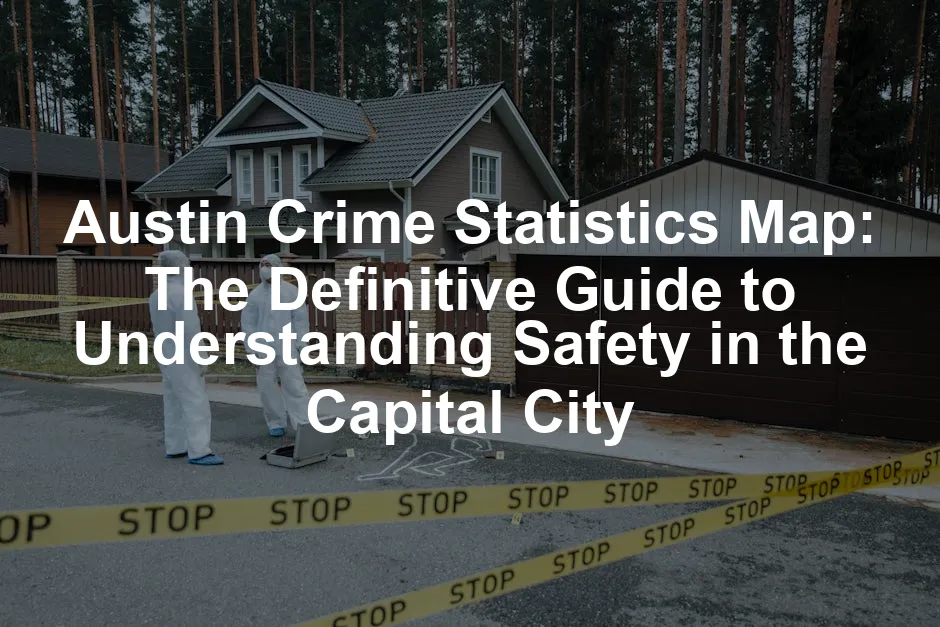Introduction
In a city as vibrant as Austin, the music capital of the world, it can be easy to overlook the shadows lurking behind the melodies. As the population grows, so do the complexities of urban life, including crime. But fear not! With the help of crime statistics maps, residents and visitors alike can navigate the streets more safely and be informed about their surroundings.
Austin’s charm is undeniable. It’s a place where live music fills the air, and food trucks serve up some of the best bites you can find. But lurking beneath the surface is a reality that many wish to ignore: crime. Understanding the crime landscape is essential for anyone living in or visiting the city. With tools like crime statistics maps, you can gain insights into the safety of neighborhoods and enhance your awareness.
So how do crime maps work? Essentially, these maps utilize data from law enforcement agencies to provide a visual representation of crime incidents across various neighborhoods. They categorize incidents, ranging from burglaries to assaults, allowing users to see where crime is more prevalent. This is particularly useful for newcomers or even long-time residents looking to make informed decisions about their surroundings.
For instance, the Austin Police Department’s CrimeViewer offers a web mapping application that allows users to search by neighborhood and type of crime. It’s important to remember that not all crime is created equal. Some areas may appear to have higher crime rates due to factors like foot traffic from tourists or proximity to nightlife.
And speaking of safety, why not take proactive measures to protect yourself? A Personal Safety Alarm can be a game-changer. This little device can emit a loud sound to draw attention in case of an emergency, making it a must-have for anyone who values their safety while out and about.
In this guide, we’ll explore the intricacies of Austin’s crime landscape, from understanding the data behind the maps to practical tips for staying safe. We’ll look at the different categories of crime, highlight neighborhoods to watch, and provide insights into using these maps effectively. So, whether you’re a local, a newcomer, or just passing through, grab your virtual map and let’s navigate the numbers together!

For a deeper understanding of how to effectively analyze crime data, check out this article on an introduction to statistical learning with python book length.
Summary of Key Points
- Understanding Crime Statistics: Austin has a crime rate that is 77.7% higher than the national average, with significant variations between neighborhoods.
- Crime Categories: Crime can be divided into violent and property crimes, with specific statistics showing alarming rates in certain areas.
- Using Crime Maps Effectively: Tools like CrimeViewer and Safemap provide valuable insights into crime trends and hotspots.
- Local Perception and Safety: Survey results reveal a divided perception of safety among residents, highlighting the need for community engagement.
- Neighborhood Insights: Specific neighborhoods have distinct crime trends; knowing these can help in making informed decisions about living and visiting areas.
- Year-Over-Year Trends: An increase in crime rates necessitates ongoing community and law enforcement efforts.
Armed with this knowledge, you can confidently traverse Austin’s eclectic streets while staying informed about the potential risks. Remember, being aware is half the battle in ensuring your safety and that of your loved ones.
But what if you want to enhance your home security? A comprehensive Home Security System can provide peace of mind whether you’re home or away. These systems come equipped with cameras, alarms, and monitoring services that can deter potential intruders and alert you to any suspicious activity.
Understanding Crime Statistics in Austin
Crime Rate Overview
Austin is a lively city, but it’s also facing significant crime challenges. According to the latest FBI statistics from 2022, the overall crime rate in Austin stands at an alarming 4,130 incidents per 100,000 residents. This figure is 77.7% higher than the national average, which sits at 2,324 incidents per 100,000. Texas itself has a lower crime rate of 2,732 incidents per 100,000, highlighting how Austin’s crime rate is not just a local issue, but a broader concern.
When we break down the statistics, the numbers paint a vivid picture. For example, Austin reported 5,215 violent crimes, which translates to 540 violent crimes per 100,000 people. This is a staggering 46.1% higher than the national average of 370. Property crimes in Austin are also concerning, with 34,650 reported incidents, equating to 3,590 per 100,000. This is 83.7% above the national average. The numbers tell us that residents and visitors should be more vigilant about their surroundings.
Violent vs. Property Crimes
Understanding the types of crimes occurring can help residents make informed decisions. Violent crimes include serious offenses like murder, assault, and robbery. In Austin, there were 69 murders, 3,679 assaults, and 939 robberies recorded in 2022. These statistics reveal a troubling trend. The implications are clear: residents need to be cautious, particularly in areas known for higher violent crime rates.
On the other hand, property crimes encompass theft, burglary, and vehicle theft. In Austin, theft incidents alone reached a staggering 24,481, while burglaries accounted for 4,816. This disparity between violent and property crimes suggests a unique urban challenge. Although property crimes may not seem as immediately dangerous, they can significantly impact residents’ peace of mind and sense of security.
And speaking of peace of mind, consider having a Fire Extinguisher in your home. You never know when an unexpected situation may arise, and being prepared can make all the difference.
Using Crime Maps Effectively
Introduction to Crime Maps
Crime maps are valuable tools that provide visual representations of crime data across a city. They help residents and visitors identify where crimes occur and what types are prevalent. By using these maps, individuals can make informed choices about their travel routes, neighborhoods to visit, and areas to avoid. For instance, a quick glance at a crime map can reveal hotspots for certain crimes, making it easier to navigate safely.
Detailed Overview of CrimeViewer
One of the most effective crime mapping tools available is the Austin Police Department’s CrimeViewer. This web application allows users to access detailed crime information. Here’s how to navigate it:
- Visit the CrimeViewer website: Start by heading to the Austin Police Department’s CrimeViewer interface.
- Use the Search Features: You can search by address, intersection, or street. This feature helps you pinpoint crime data in specific locations.
- Explore Crime Categories: The tool categorizes crimes into Part I and Part II offenses. Part I crimes include serious offenses like murder and aggravated assault, while Part II includes minor offenses.
- Generate Thematic Reports: Users can create reports based on crime types, years, and districts for a tailored view of crime in Austin.
The data provided is updated monthly, ensuring users have access to the latest statistics. However, it’s essential to approach this information critically. High crime rates in certain areas may be influenced by factors like tourism or nightlife, rather than indicating a lack of safety.
By using tools like CrimeViewer, residents can stay informed and make choices that enhance their safety in Austin. Whether you’re a long-time local or a visitor, understanding the crime landscape is crucial for navigating the city confidently.

Don’t forget to keep your electronic devices charged while navigating the city! A Portable Phone Charger is essential for those long days out. It ensures you stay connected and can access important information at all times.
Neighborhood Crime Rates
Overview of Neighborhoods
Austin is a city of contrasts, especially when it comes to crime rates. Each neighborhood tells its own story, with some areas experiencing a crime surge while others bask in relative safety. From the bustling Downtown to the serene suburbs, crime rates vary dramatically across the city.
For instance, neighborhoods like Central Austin and South Congress often see higher crime rates due to their vibrant nightlife and tourist attractions. In contrast, places like Northwest Hills and Crestview tend to be safer, showcasing a blend of community engagement and lower foot traffic. This diversity in crime rates highlights why understanding your neighborhood is paramount for residents and newcomers alike.
High Crime Areas
When it comes to crime, certain neighborhoods stand out for all the wrong reasons. Downtown Austin, for instance, is notorious for its elevated crime rates. In 2022, this area reported over 10,821 total crimes, including 2 murders and nearly 2,000 thefts. South Austin is not far behind, with 13,097 reported crimes, showcasing the challenges faced in urban environments.
Statistics reveal that violent crime in these high-density areas can be particularly alarming. For example, Downtown’s robbery rate stands at 91 incidents, contributing to a total of 5,215 violent crimes across the city. The reality is that these neighborhoods, while lively and culturally rich, come with heightened risks. Understanding these statistics can inform residents and visitors about potential dangers, allowing them to take precautions when exploring these vibrant areas.
Speaking of precautions, consider investing in a Self-Defense Keychain. It’s a discreet yet effective tool for personal safety, ensuring you feel empowered wherever you go.
Safer Neighborhoods
On the flip side, Austin is home to several neighborhoods that boast lower crime rates, making them more appealing for families and individuals seeking peace of mind. Areas like Tarrytown and the Domain offer a sense of security with crime rates significantly below the city average. These neighborhoods benefit from community programs, active neighborhood associations, and a strong presence of law enforcement.
In Tarrytown, for example, residents enjoy a tight-knit community atmosphere, which contributes to its safety. Well-maintained parks, regular neighborhood watch meetings, and local businesses create an environment where crime is less likely to thrive. Similarly, the Domain, known for its upscale shopping and dining, has implemented measures to ensure safety, leading to a lower overall crime rate.
Ultimately, the key to understanding Austin’s crime landscape lies in recognizing the differences between neighborhoods. While some areas may experience higher crime rates due to various factors, others stand out for their safety and community spirit. This knowledge empowers residents to make informed decisions about where to live and visit, enhancing their overall experience in this dynamic city.

Local Perception of Crime
Survey Insights
When it comes to feeling safe in Austin, the opinions are as mixed as a Texas two-step. Recent surveys conducted by AreaVibes reveal that opinions on safety in the city are evenly split. Of the 246 respondents, 49% felt secure, confidently strolling alone at night. However, the other 51% were less optimistic, expressing discomfort about their safety under the moonlight.
These numbers highlight a crucial point: perceptions of crime can vary widely from person to person. Some residents bask in the glow of Austin’s vibrant nightlife, while others remain wary of lurking dangers. This divide suggests that factors beyond just statistics shape how people feel about their safety.
Factors Influencing Perceptions
So, what influences these perceptions? A cocktail of local media coverage, community initiatives, and crime trends serves up the recipe. The media often plays a significant role, with sensational headlines having the power to spike anxiety levels. If crime stories dominate the news cycle, it can skew residents’ views, making them feel less secure than the reality might suggest.
Community initiatives also weigh in on perceptions. Neighborhood watch programs and local safety events can foster a sense of togetherness and vigilance. When residents see their neighbors actively engaging in keeping the community safe, it can bolster feelings of security. In contrast, areas with fewer community programs may experience a chillier perception of safety.
Crime trends are the cherry on top of this perception sundae. For instance, if a neighborhood experiences a spike in incidents, even if temporary, it can lead to heightened anxiety among residents. Conversely, a decrease in crime rates can help soothe fears. Understanding how these elements intertwine is key to grasping the local sentiment towards crime in Austin.

Year-Over-Year Crime Trends
Trends and Patterns
If you thought the crime statistics were daunting, wait until you see the year-over-year trends. The latest data indicates a 2.3% increase in total crime in Austin. Diving deeper, violent crime has risen by 4.4%, and property crime has increased by 1.9%.
Specifically, the FBI reported 5,215 violent crimes in Austin, equating to 540 incidents per 100,000 residents, a figure that is 46.1% higher than the national average. Property crimes were even more staggering, with a total of 34,650 incidents—3,590 per 100,000 people. This alarming trend highlights the ongoing challenges facing the city.
Implications for Residents
What does this mean for residents? The uptick in crime can have significant implications for community safety and law enforcement responses. With rising crime rates, residents may be more likely to invest in home security systems or participate in neighborhood watch programs. Additionally, increased crime rates often lead to a stronger police presence in affected areas, as law enforcement ramps up efforts to combat the trend.
However, these developments can also foster a sense of unease within the community. As crime rates rise, residents may feel increasingly anxious about their safety, leading to changes in behavior—such as avoiding certain neighborhoods or limiting nighttime outings. This dynamic can affect not just individual lives but the overall vibrancy of the community.
In summary, while the statistics may paint a grim picture, they also serve as a call to action for residents and city officials alike. By fostering community engagement and addressing crime proactively, Austin can work toward a safer environment for all its residents.

Community Engagement and Safety Initiatives
Importance of Community Involvement
Austin is a city filled with vibrant communities, and safety thrives when residents actively participate. Community programs play a vital role in reducing crime and fostering a sense of belonging. Neighborhood watch groups are popular in many areas, encouraging residents to look out for each other. These groups are not just about watching; they’re about building relationships. After all, knowing your neighbor can be the first step in creating a safer environment.
Another fantastic initiative is the Austin Police Department’s community outreach programs. These programs help bridge the gap between law enforcement and residents. Events such as “Coffee with a Cop” allow community members to engage in casual conversations with officers. These interactions help demystify the police, making them more approachable. When residents feel comfortable talking to officers, it enhances cooperation and trust, essential elements for effective crime prevention.
Moreover, local organizations often host safety workshops. These sessions cover topics from self-defense to emergency preparedness. By equipping residents with knowledge, these programs empower individuals to take action. This proactive approach not only enhances personal safety but also strengthens community ties. When neighbors know each other and share responsibility for safety, crime rates can decrease.
And speaking of emergency preparedness, don’t forget to grab an Emergency Preparedness Kit. It’s a smart investment to ensure you’re ready for any unexpected situations that may arise.
Steps Residents Can Take
Residents can take several actionable steps to engage with local law enforcement and community groups. First, consider attending neighborhood association meetings. These gatherings are perfect opportunities to discuss safety concerns and share insights about local crime trends. Getting involved creates a platform for residents’ voices to be heard.
Another effective way to engage is by volunteering for community safety initiatives. Whether it’s participating in a cleanup day or joining a local safety committee, every little bit counts. Volunteer efforts foster a sense of ownership and pride in the neighborhood. When people care about their environment, they are more likely to protect it.
Additionally, consider using platforms like Nextdoor or Facebook groups tailored for local communities. These platforms allow residents to share information about suspicious activity or neighborhood events. They can also be used to coordinate safety patrols or community events focused on crime prevention.
Lastly, don’t hesitate to reach out to the Austin Police Department directly. They often welcome community feedback and input. Residents can report concerns or request information on crime trends. This communication strengthens the partnership between law enforcement and the community. Together, they can work towards building a safer Austin.
In conclusion, community engagement is crucial for a safer Austin. By participating in local initiatives and fostering communication with law enforcement, residents can contribute to reducing crime and enhancing their neighborhoods. Remember, safety is a shared responsibility, and every action counts!

Conclusion
As Austin continues to grow and evolve, understanding the complexities of crime statistics is essential for maintaining safety and security. By utilizing tools like crime maps and staying informed about local trends, residents can navigate their environment with greater confidence. Ultimately, it’s a community effort to foster a safe and vibrant city, where everyone can enjoy the rich culture and opportunities that Austin has to offer.
And while you’re out exploring, don’t forget to stay hydrated! An Insulated Water Bottle is perfect for keeping your drinks cold while you’re on the go!
Please let us know what you think about our content by leaving a comment down below!
Thank you for reading till here 🙂
All images from Pexels




